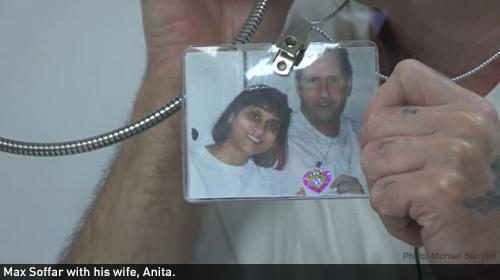
Max Soffar has a long history of self-medicating. When he was four, his parents found him passed out next to their car, gas cap in hand. Since birth, Max's brain has been damaged. That damage has been made worse by years of physical and mental abuse by adoptive parents and staff at mental institutions.
At the age of 24 in 1980, Max had the mentality of an 11-year-old. His brain was "fried," according to police, who knew him as a dropout and wannabe police informant. Officers arrested Max on a stolen motorcycle after an infamous robbery-murder at a Houston bowling alley that year.
The police locked Max in a small room and subjected him to a three-day marathon of aggressive, unrecorded interrogation – marked by prodding, pressure, and lies – which culminated in a false confession, typed by police, that the officers convinced a worn down Max to sign.
Max has spent the last 34 years on death row in Texas, but he won't be alive long enough to be executed. Max has terminal liver cancer. The question isn't whether he will die; it is only how soon and where: behind bars or at home.
Meet Max:


%3Ciframe%20allowfullscreen%3D%22%22%20frameborder%3D%220%22%20height%3D%22281%22%20src%3D%22%2F%2Fwww.youtube.com%2Fembed%2FDfSkw9X0PFo%3Fautoplay%3D1%26autoplay%3D1%26version%3D3%22%20width%3D%22500%22%3E%3C%2Fiframe%3E
Privacy statement. This embed will serve content from youtube.com.
The forced confession is the only evidence tying Max to the murder. The state has no DNA, no fingerprints, and no forensic or other reliable evidence to connect Max to the crime. What's more, and as several appeals judges have found over the years, the confession is demonstrably false: It narrates a story that clashes dramatically with the account of the only surviving witness and with the other known evidence of how the crime occurred.
It's not just the fact that the state put Max on death row with only a false confession. This whole story of justice gone miserably awry is made worse by the large mountain of evidence implicating another man, who died on Tennessee's death row in 2013.
The man's name is Paul Reid. The week before the shootings, Reid got into an altercation with employees at the bowling alley and threatened to blow their heads off. He was living and committing robberies in Houston at the time, and he wasn't at home with his wife on the night the shootings occurred. Reid looks like the police composite of the shooter, and he went on to commit a series of similar crimes in Tennessee, for which he was caught.
But this evidence of innocence alone won't help Max make it home, to die in the arms of his loving wife Anita. Max has spent the last 34 years on death row because of numerous errors during his original trial and a lugubrious appeals process that will not be over before Max dies.
It falls to Gov. Rick Perry to show Max mercy by using his power to grant him clemency. This innocent man should be allowed to die at home, with the support of his friends and family.
Find out more about how you can urge Governor Perry to let Max go home, before the state of Texas lets an innocent man die on their death row.
Learn more about the death penalty and other civil liberty issues: Sign up for breaking news alerts, follow us on Twitter, and like us on Facebook.


